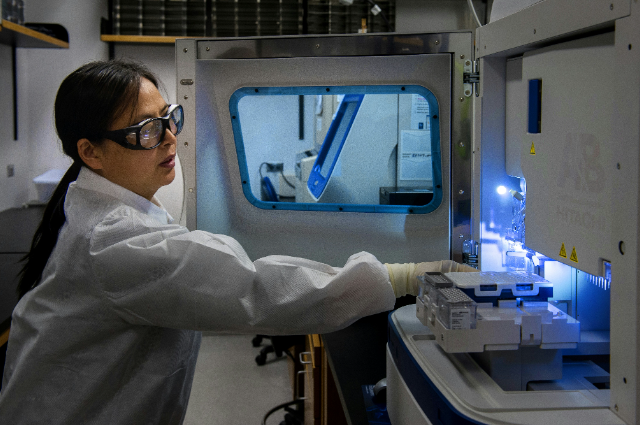
Photo by CDC on Unsplash / Representative Image
Researchers at the Medical University of Vienna have made significant strides in understanding how humans perceive heat. A team of scientists led by Michael Fischer from the Centre for Physiology and Pharmacology at MedUni Vienna has discovered a specific type of cell structure involved in heat recognition.
The Role of Cell Structures in Heat Perception
The study published in Science Advances examined 48 healthy test subjects using a newly developed heat pain model to clarify the role of various cell components in heat perception. Surprisingly, the researchers found that the perception of heat pain in humans differs significantly from the way it works in mice.
In mice, the cell structures TRPV1, TRPA1, and TRPM3 are redundantly responsible for heat perception and a role for ANO1 was also described. However, the study revealed that three of these four cell structures play no role in humans.
The Importance of TRPV1 in Human Heat Perception
The fourth structure, TRPV1 which is also responsible for the perception of spicy food has proved to be the most sensitive for recognizing heat in humans. While TRPV1 remains the central detector of noxious heat, the majority of protective heat avoidance in everyday life depends on the other as yet unknown, molecular mechanisms in humans.
Implications for Future Research and Therapies
When TRPV1 was withdrawn, it reduced pain at harmful temperatures but the majority of heat-induced pain was still perceived. These findings open up new avenues in research into recognizing and preventing heat damage and could lead to new therapies in the long term, according to study leader Michael Fischer.
The groundbreaking research conducted by the Medical University of Vienna has significantly advanced our understanding of how humans perceive heat. By identifying the role of specific cell structures and the importance of TRPV1, this study paves the way for future research and potential therapies aimed at recognizing and preventing heat damage.
The Fascinating World of Thermal Perception: How Our Environment Shapes Our Minds?
Human cognition and perception are deeply intertwined with environmental factors and one key element that influences these processes is temperature. According to the theory of grounded cognition, the mind, body, and environment form a connected system meaning that even abstract reasoning is shaped by physical experiences and sensorimotor memories. Temperature as a fundamental environmental factor affects not only our physical well-being but also the way we think and perceive the world around us.
Temperature and its Role in Survival
Temperature regulation is crucial for our survival because the body and brain must maintain a stable internal environment for optimal function. To achieve this, our bodies have specialized sensory receptors known as thermoreceptors. These thermoreceptors are located in the skin and are responsible for sensing temperature changes. They send signals through the thermosensory spinothalamic tract to the brain enabling us to perceive whether something is hot or cold.
The body has different thermoreceptors for cold and warm stimuli, allowing for a sophisticated response to temperature variations. In warmer environments, warm thermoreceptors are more active while cold thermoreceptors dominate in cooler settings. This balance allows us to not only detect temperature changes but also prepare our bodies for potential fluctuations, helping us maintain stability.
The Brain’s Processing of Thermal Sensations
Once thermoreceptors transmit temperature signals, these are processed by the brain specifically the posterior insular cortex. This area is the primary centre for interpreting thermal sensations both in terms of detecting temperature differences and emotional responses to warmth or cold. The posterior insular cortex also plays a role in interoception which is the body’s ability to sense its internal state including temperature.
Thermoregulation—our body’s process for managing internal temperature involves both unconscious and conscious actions. Reflexive actions like shivering or sweating help maintain body temperature, while conscious behaviours such as putting on warmer clothing are equally important. Research has shown that thermal sensations from different body parts, particularly the head are crucial for maintaining thermal comfort. Peripheral temperature or the temperature of the skin seems to have a greater impact on our sense of comfort than core body temperature.
Temperature plays an essential role in shaping human perception and cognition. Through the activity of thermoreceptors and brain processing in the insular cortex, we maintain an awareness of our environment and regulate our body’s internal state. This complicated system ensures that humans can adapt to changing temperatures by ensuring both survival and comfort.
Quantifying Temperature Sensitivity
Previous research has focused on quantifying human temperature sensitivity by applying thermal stimuli to specific areas of the body. These studies have identified distinct temperature ranges with varying thermal perceptions: extremely cold or hot (< 15 °C/> 45 °C) and comfortably cool or warm (15 °C < T < 30 °C / 30 °C < T < 45 °C). The thermal stimulus typically involves a small thermode—a compact metal plate capable of controlled cooling and heating.
This research has revealed varying thermal sensitivities across different body parts, with the head being more sensitive to warm temperatures and the torso more responsive to cold stimuli. A recent study by Crucianelli et al. (2021) found that the minimum difference participants could perceive (the just noticeable difference, JND) in cold stimuli applied to the palm is 2.02 °C, while it is 1.48 °C on the forearm. For warm stimuli, the JND on the palm is 2.65 °C, and on the forearm, it is 2.61 °C.
Our perception and understanding of the world are profoundly influenced by the temperature of our environment. The grounded cognition theory suggests that our minds, bodies, and environment are interconnected, and temperature plays a crucial role in this relationship. By understanding the mechanisms behind thermal perception and the brain's role in thermoregulation, we can gain valuable insights into how our environment shapes our minds and cognition.
. . .
References:
